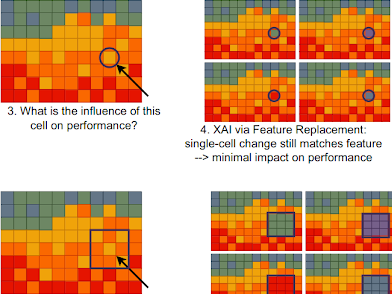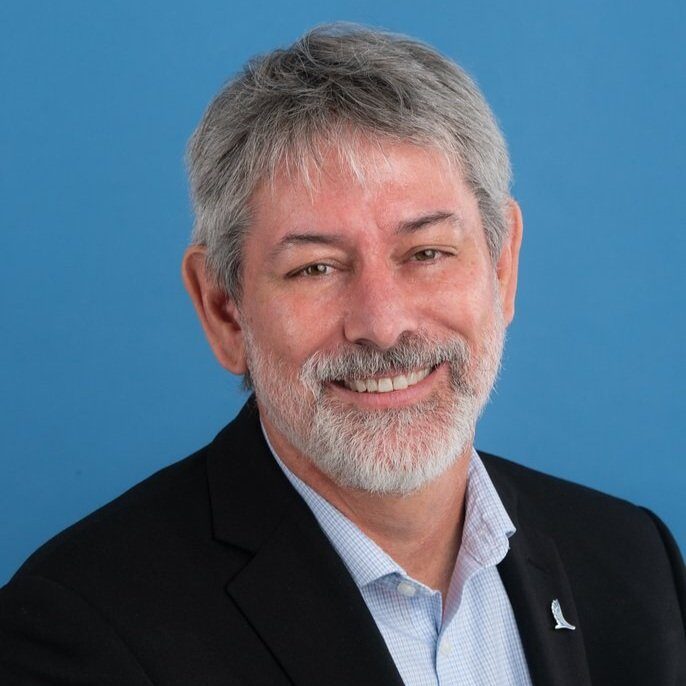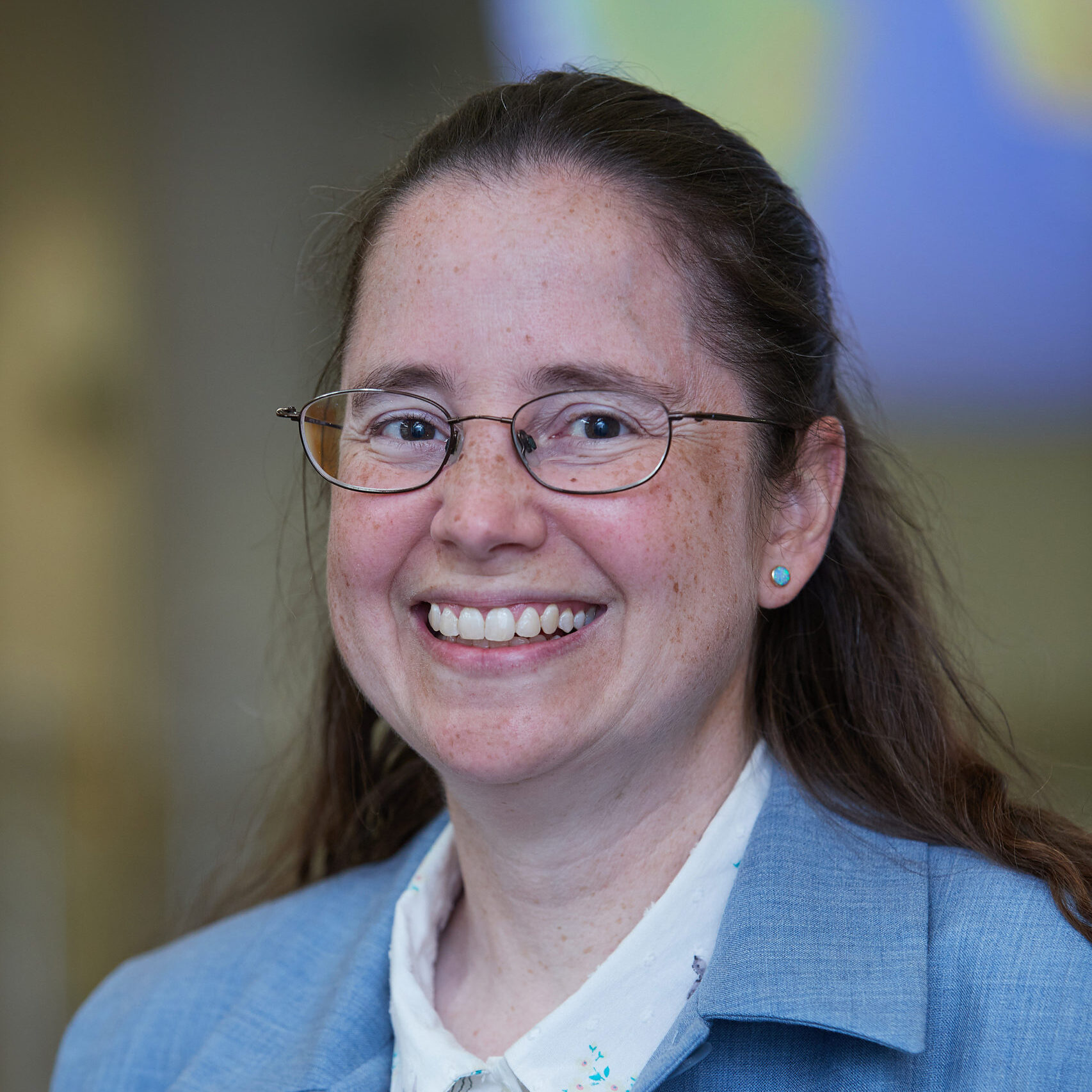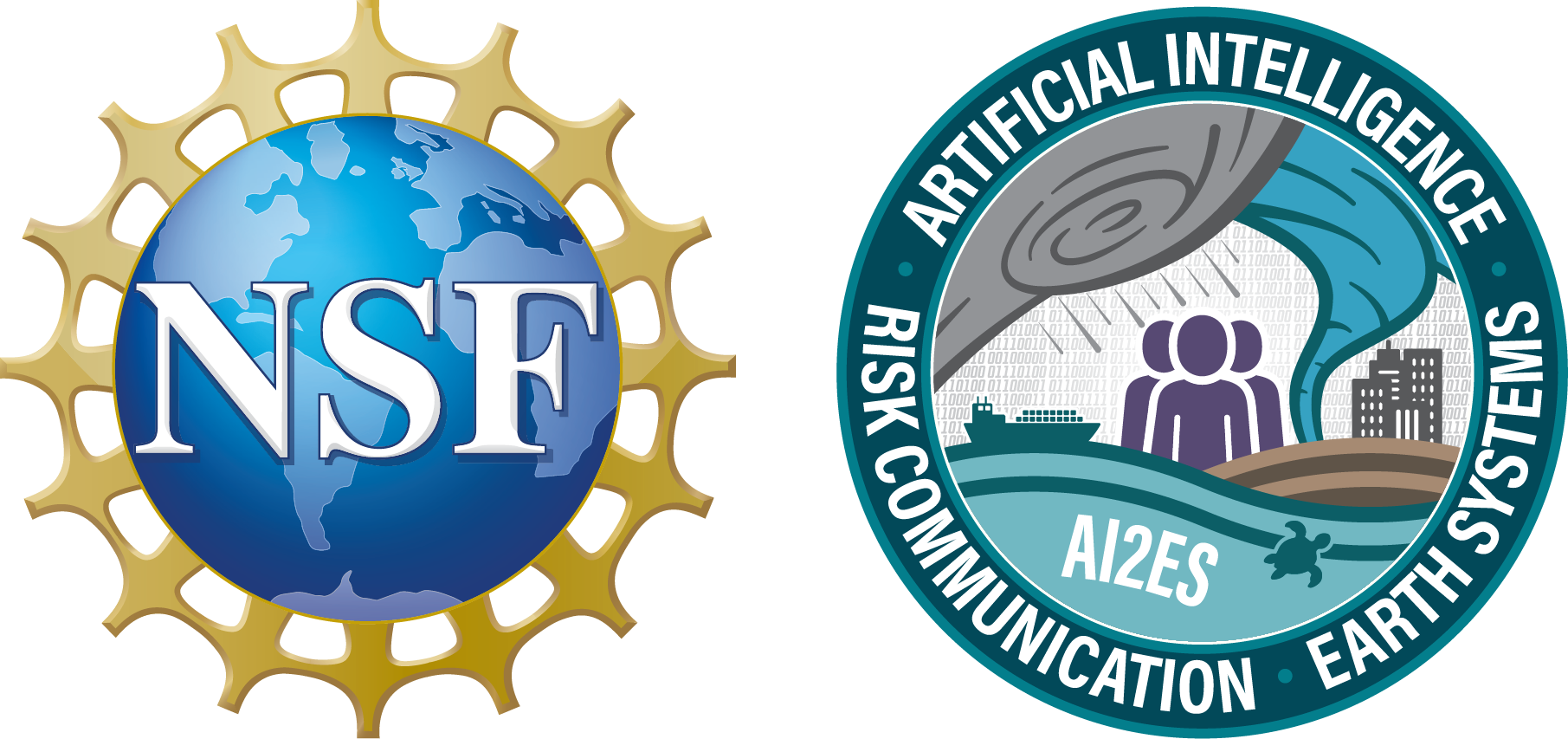Foundational Research
Foundational AI
Making breakthroughs in foundational AI through the lens of convergent, use-inspired research, impacting both the computer and Earth system science research communities.

Explainable AI (XAI)
Novel XAI and interpretable techniques for Earth system science applications.

Physics-Based AI
Integrating physical properties and domain knowledge into AI models.

Robust AI
Methods for handling disproportional or adversarial data in ES contexts.

AI Ethics
Ethical and responsible AI for weather and Earth system science applications.
Explainable Artificial Intelligence (XAI)
Improving XAI for Geoscience Models




One of the focal points of our mission is developing and vetting XAI techniques that work in Earth system science, environmental science, and geospatial applications. We developed a deeper understanding of the drawbacks of existing XAI methods on Earth system (ES) data and developed novel XAI methods for ES needs. By first studying simulated ES data, we systematically identified the shortcomings of existing ES techniques to learn how to 1) utilize and interpret the results from these XAI methods when used in ES applications and 2) develop new XAI techniques specifically tailored to the needs of ES users and data. These insights have been widely distributed, positively impacting the broader scientific community.
XAI algorithms are highly sensitive to correlated features which poses a difficult challenge for evaluating geospatial models since geospatial data tends to have extensive autocorrelation, yielding misleading explanations. Our work revealed that analyzing explanations across multiple grouping schemas provide more accurate insights into the scale of the learned features enhancing model interpretation, as shown in our FogNet case study for coastal fog prediction. One of our new XAI methods created can be see in the image to to the left (see Figure).
Related Project: Coastal Fog Predictions: FogNet
Highlighted Publications and Releases
A. Mamalakis, E. A. Barnes, and I. Ebert-Uphoff. Investigating the fidelity of explainable artifi- cial intelligence methods for applications of convolutional neural networks in geoscience. Artificial Intelligence for the Earth Systems, 1(4), Oct. 2022. doi:10.1175/AIES-D-22-0012.1.
A. Mamalakis, E. A. Barnes, and I. Ebert-Uphoff. Carefully choose the baseline: Lessons learned from applying XAI attribution methods for regression tasks in geoscience. Artificial Intelligence for the Earth Systems, 2(1):e220058, Jan. 2023. doi:10.1175/AIES-D-22-0058.1.
E. Krell. Using Hierarchical Superpixels To Improve Neural Network Attributions For Geospatial Models. Dissertation. PhD thesis, Texas A&M Corpus Christi, 2024.
E. Krell, H. Kamangir, W. Collins, S. A. King, and P. Tissot. Aggregation strategies to improve XAI for geoscience models that use correlated, high-dimensional rasters. Environmental Data Science, 2:e45, Dec. 2023. doi:10.1017/eds.2023.39.
H. Kamangir, E. Krell, W. Collins, S. A. King, and P. Tissot. Importance of 3D convolution and physics on a deep learning coastal fog model. Environmental Modelling & Software, 154:105424, Aug. 2022. doi:10.1016/j.envsoft.2022.105424.
Novel Interpretable AI Methods
NSF AI2ES has also developed novel interpretable AI methods, which are methods that are directly interpretable rather than requiring post-hoc methods such as XAI. In addition, we have made novel developments in XAI for geoscience applications. For example, some XAI approaches in the computer science domain do not take into account the location of observed phenomena, adversely affecting their efficacy on Earth system science data sets. Our team members at CSU have devised a new version of an XAI approach that incorporates the importance of location.
Similarly, we have integrated existing explainability tools to identify and describe novel patterns and pertinent indicators, e.g. indicators of the changing weather patterns and the increasing rates of severe weather events.
Related Project: Interpretable AI for S2S




Highlighted Publications and Releases
E. A. Barnes, R. J. Barnes, Z. K. Martin, and J. K. Rader. This looks like that there: Interpretable neural networks for image tasks when location matters. Artificial Intelligence for the Earth Systems, 1(3), July 2022. doi:10.1175/AIES-D-22-0001.1.
J. Stock and C. Anderson. Memory-based sequential attention. In Proceedings of The 2nd Gaze Meets ML workshop, volume 226, pages 236–253. PMLR, Dec. 2023. https://proceedings.ml r.press/v226/stock24a.html.
C. Anderson and J. Stock. An interpretable model of climate change using correlative learning. In NeurIPS 2022 Workshop on Tackling Climate Change with Machine Learning, 2022. https: //www.climatechange.ai/papers/neurips2022/82.
C. Anderson, J. Stock, and D. Anderson. Interpretable climate change modeling with progressive cascade networks, May 2022. arXiv:2205.06351 [cs]. doi:10.48550/arXiv.2205.06351.
A. S. Bansal, Y. Lee, K. Hilburn, and I. Ebert-Uphoff. Leveraging spatiotemporal information in meteorological image sequences: From feature engineering to neural networks. Environmental Data Science, 2:e31, July 2023. doi:10.1017/eds.2023.26.
J. K. Rader and E. A. Barnes. Optimizing seasonal-to-decadal analog forecasts with a learned spatially-weighted mask. Geophysical Research Letters, 50(23):e2023GL104983, Nov. 2023. doi: 10.1029/2023GL104983.
J. K. Rader, E. A. Barnes, I. Ebert-Uphoff, and C. Anderson. Detection of forced change within combined climate fields using explainable neural networks. Journal of Advances in Modeling Earth Systems, 14(7):e2021MS002941, June 2022. doi:10.1029/2021MS002941.
Physics-Based AI
Addressing the complexities of ES phenomena necessitates AI techniques that integrate the physical properties and domain knowledge. Our work in physics-based and physics-inspired AI enables models to capture complex processes such as ocean wave formation, coastal water level dynamics, tropical cyclones/disturbances, atmospheric convection, and coastal fog formation.
Our prior work incorporating physics-based approaches and domain knowledge has advanced the field, providing positive impact across a large span of critical ES related prediction and analysis tasks, including improved satellite observation and prediction of weather phenomena, advanced feature extraction for meteorological imagery, the use of mathematical methods, such as topological data analysis, for feature engineering. Furthermore, we have made improvements in remote sensing from high-resolution imagery, evaluation and improvement of global weather forecasting, and uncertainty quantification of meteorological events.
Our development of OceanNet successfully demonstrates the potential of physics-inspired neural operator-based models by addressing distinct challenges, including flow non-linearity and spectral bias, that are inherent in modeling complex ocean phenomena, such as Loop Current eddies and the Gulf Stream meander. In 2024, in collaboration with funding with NSF NCAR, NSF AI2ES personnel released an open-source community AI NWP model (CREDIT) with a key goal of facilitating physics-based AI research .
Related Projects: Physics-Inspired AI for Offshore Oceanography, Coastal Inundation, Hail Nowcasting, Coastal Fog Predictions: FogNet






Highlighted Publications and Releases
A. Chattopadhyay, M. Gray, T. Wu, A. B. Lowe, and R. He. OceanNet: A principled neural operator- based digital twin for regional oceans. Scientific Reports, 14(1):21181, 2024.
N. Chaichitehrani, R. He, and M. N. Allahdadi. Forecasting ocean waves off the U.S. East Coast using an ensemble learning approach. Artificial Intelligence for the Earth Systems, 3(3):230061, 2024. doi:10.1175/AIES-D-23-0061.1.
M. A. Chan, M. J. Molina, and C. Metzler. Estimating epistemic and aleatoric uncertainty with a single model. In The Thirty-eighth Annual Conference on Neural Information Processing Systems, 2024. https://openreview.net/forum?id=WPxa6OcIdg.
M. Vicens-Miquel, P. E. Tissot, K. F. Colburn, D. D. Williams, M. J. Starek, J. Pilartes-Congo, M. Kastl, S. Stephenson, and F. A. Medrano. Machine-learning predictions for total water levels on a sandy beach. Journal of Coastal Research, 2024.
M. Vicens-Miquel, D. D. Williams, and P. E. Tissot. Analysis of sandy beach morphology changes and inundation events from a high spatiotemporal resolution dataset. Journal of Coastal Research, 2024.
T. G. Schmidt, A. McGovern, J. T. Allen, C. K. Potvin, R. J. Chase, C. M. Wiley, W. R. McGovern- Fagg, M. L. Flora, C. R. Homeyer, and J. K. Williams. Gridded severe hail nowcasting using 3D U-Nets, lightning observations, and the Warn-on-Forecast system. Artificial Intelligence for the Earth Systems, 2024.
Y. Sha, R. A. Sobash, and D. J. Gagne. Generative ensemble deep learning severe weather predic- tion from a deterministic convection-allowing model. Artificial Intelligence for the Earth Systems, 3(2):e230094, 2024. doi:10.1175/AIES-D-23-0094.1.
H. Kamangir, E. Krell, W. Collins, S. A. King, and P. Tissot. Importance of 3D convolution and physics on a deep learning coastal fog model. Environmental Modelling & Software, 154:105424, Aug. 2022. doi:10.1016/j.envsoft.2022.105424.
Y. Lee, C. D. Kummerow, and I. Ebert-Uphoff. Applying machine learning methods to detect convection using Geostationary Operational Environmental Satellite-16 (GOES-16) advanced base- line imager (ABI) data. Atmospheric Measurement Techniques, 14(4):2699–2716, Apr. 2021. doi:10.5194/amt-14-2699-2021.
J. Stock and C. Anderson. Attention-based scattering network for satellite imagery. In NeurIPS 2022 Workshop on Tackling Climate Change with Machine Learning, 2022. https://www.climatecha nge.ai/papers/neurips2022/7.
J. Stock and C. Anderson. Attention-based scattering network for satellite imagery. In NeurIPS 2022 Workshop on Tackling Climate Change with Machine Learning, 2022. https://www.climatecha nge.ai/papers/neurips2022/7.
C. H. White, I. Ebert-Uphoff, J. M. Haynes, and Y.-J. Noh. Superresolution of GOES-16 ABI bands to a common high resolution with a convolutional neural network. Artificial Intelligence for the Earth Systems, 3(2):e230065, Apr. 2024.
J.Schreck,Y.Sha,W.Chapman,D.Kimpara,J.Berner,S.McGinnis,A.Kazadi,N.Sobhani,B.Kirk, and D. J. Gagne. Community research Earth digital intelligence twin (CREDIT). arXiv [cs.AI], Nov. 2024. doi:10.48550/arXiv.2411.07814.
Robust AI
Traditional methods for disproportional or adversarial data do not address conditions that are often present in ES data sets. NSF AI2ES has developed new approaches to address these challenges both theoretically through foundational AI research and empirically by creating new robust AI solutions to ES problems.
For example, we advanced fundamental knowledge of how to reliably learn models in the case where there is class imbalance in the data set. With respect to ES data, we evaluated well-established, robust AI approaches, tackling challenges including data corruption and unreliable labels, and determined their applicability and possible benefit to understanding and predicting ES phenomena, such as swell waves, convection storm mode, and wind intensity. We integrated other robustness approaches, including ensemble modeling, working with verifiably corrupted inputs, as well as self-training with pseudo-labels, increasing prediction accuracy and model robustness beyond what can be achieved with traditional AI approaches.
This work inspired the follow-on development of a novel method of meta-learning which leverages multiple representations of a data set to improve few-shot prediction accuracy. Application of these techniques advanced the state-of-the-art performance in benchmark computer vision tasks and on real-world road-surface classification. Along this journey on pseudo-labels our researchers have written a definitive survey of approaches that use pseudo-labels in collaboration with the University of Edinburgh.
Related Projects: Winter Road Weather/Decision Making





Highlighted Publications and Releases
D. I. Diochnos and T. B. Trafalis. Learning Reliable Rules under Class Imbalance. In C. Demeniconi and I. Davidson, editors, Proceedings of the 2021 SIAM International Conference on Data Mining, SDM 2021, Virtual Event, April 29 – May 1, 2021, pages 28–36. SIAM, 2021. doi:10.1137/1.97 81611976700.4.
D. Diochnos. Learning reliable rules under class imbalance. https://github.com/diochnos/pac-imbalanced, 2021. Software release.
C. Flansburg and D. I. Diochnos. Wind prediction under random data corruption (student abstract). Proceedings of the AAAI Conference on Artificial Intelligence, 36(11):12945–12946, June 2022. Number: 11. doi:10.1609/aaai.v36i11.21609.
R. A. Sobash, D. J. Gagne, C. L. Becker, D. Ahijevych, G. N. Gantos, and C. S. Schwartz. Diagnosing storm mode with deep learning in convection-allowing models. Monthly Weather Review, 151(8):2009–2027, July 2023. doi:10.1175/MWR-D-22-0342.1.
N. Chaichitehrani, R. He, and M. N. Allahdadi. Forecasting ocean waves off the U.S. East Coast using an ensemble learning approach. Artificial Intelligence for the Earth Systems, 3(3):230061, 2024. doi:10.1175/AIES-D-23-0061.1.
V.A. Ferrera, J.C. Rothenberger, M.W. Reyes, C. Sutter, A.H. Fagg, and D.I. Diochnos. Classifying road surface conditions with self-trained artificial intelligence. In 103rd AMS Annual Meeting. AMS, 2023.
J. C. Rothenberger and D. I. Diochnos. Meta co-training: Two views are better than one. Preliminary version presented at the Eighteenth International Symposium on Artificial Intelligence and Mathe- matics (ISAIM) 2024; currently under submission, 2023. doi:10.48550/ARXIV.2311.18083.
J. C. Rothenberger, T. Le, C. Sutter, K. J. Sulia, and D. Diochnos. Improving road surface classification with co-training algorithms. In 105rd AMS Annual Meeting. AMS, 2025.
P. Kage, J. C. Rothenberger, P. Andreadis, and D. I. Diochnos. A review of pseudo-labeling for computer vision, 2024. doi:10.48550/arXiv.2408.07221. (under review).
Uncertainty Quantification (UQ) for Earth System Science
In addition, our researchers have developed methods of quantifying uncertainty in Earth System Sciences. Our collaborators at NSF NCAR developed a new python package, MILES GUESS, which provides Keras and Pytorch implementations of evidential deep learning models and supports analysis of aleatoric and epistemic uncertainties. This package enables both categorical and regression task evidential learning.
Highlighted Publications and Releases
J. S. Schreck, D. J. Gagne, C. Becker, W. E. Chapman, K. Elmore, D. Fan, G. Gantos, E. Kim, D. Kimpara, T. Martin, M. J. Molina, V. M. Przybylo, J. Radford, B. Saavedra, J. Willson, and C. Wirz. Evidential deep learning: Enhancing predictive uncertainty estimation for Earth system science applications. Artificial Intelligence for the Earth Systems, 2024. doi:10.1175/AIES-D-23-0093.1.





AI Ethics





NSF AI2ES had an immediate impact on the burgeoning field of ethical and responsible AI for weather and climate. We published a paper for a wide audience detailing why ethical and responsible AI was needed for weather and climate applications. Until this point, although the need for ethical AI was becoming more widely appreciated in the broader AI community, many of the potential pitfalls did not appear to apply to weather and climate applications. This paper led to multiple talks and media appearances for broader impact to the wide community. Members of NSF AI2ES led key contributions to the development of a general framework for ethical AI for the geosciences, led by AGU. Our third paper introduced a categorization of bias focused on AI for ES applications.
Highlighted Publications and Releases
A. McGovern, I. Ebert-Uphoff, D. J. Gagne, and A. Bostrom. Why we need to focus on developing ethical, responsible, and trustworthy artificial intelligence approaches for environmental science. Environmental Data Science, 1:e6, Apr. 2022. doi:10.1017/eds.2022.5.
S. Stall, G. Cervone, C. Coward, J. Cutcher-Gershenfeld, T.J. Donaldson, C. Erdmann, R.B. Hanson, J. Holm, J. L. King, L. Lyon, D. P. MacNamara, A. McGovern, R. McGranaghan, A. A. Narock, M. S. Parker, G. Peng, Y. d. Rao, E. Ryan, B. Sedora, S. Shekhar, K. Vrouwenvelder, L. A. Waller, C. D. Wirz, and AGU AI/ML Ethics Workshop Participants. Ethical and responsible use of AI/ML in the earth, space, and environmental sciences. Authorea Preprints, April 2023.
A. McGovern, A. Bostrom, M. McGraw, R. J. Chase, D. J. Gagne, I. Ebert-Uphoff, K. D. Musgrave, and A. Schumacher. Identifying and categorizing bias in ai/ml for Earth sciences. Bulletin of the American Meteorological Society, 105(3):E567 – E583, 2024. doi:10.1175/BAMS-D-23-0196.1.
Advancing AI in Earth System Science Research
Join us to unlock AI’s potential in science.
